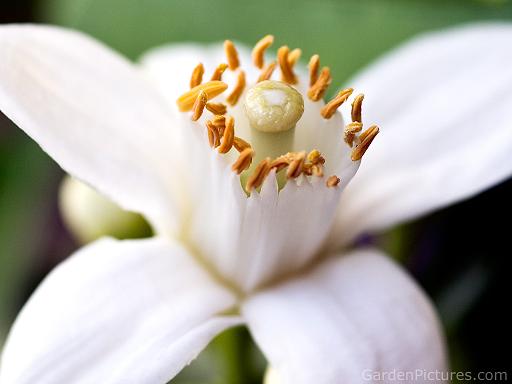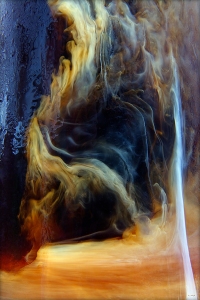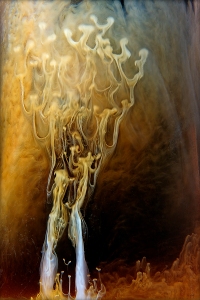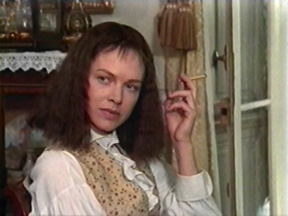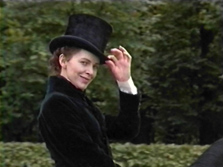The slim figure hurriedly dismounted from the horse and strode into the house. It was a blur of movement in a billowing white shirt and tightly fitted leather pants that still carried the lingering traces of the saddle and horse. A small, thin cheroot cigar was placed between firm, full lips that smiled broadly upon seeing the old-fashioned library parlour. It was filled with comfortable, shabby armchairs broken in from use and covered in a faded chintzy material. Books lay strewn over all the tables, while the smell of old paper wafted from the many bookcases that lined the walls. A large vase of flowers stood in the sunlight that streamed through the large, open windows, and the smell of neroli orange blossoms filled in the air. At times bitter, at times languidly soft and heady, their aroma swirled around the tobacco from the cheroot, the leather, and the faintest trace of powdered heliotrope from the garden outside. A warm, golden haze filled the room, welcoming, beckoning. George was home. Her home.
George is a perfume from Jardins d’Ecrivains, a perfume house founded by Anaïs Biguine. It is a small, French niche house that originally began with scented candles before releasing perfumes in 2012. George was the first of five, and all the fragrances are inspired by famous French literature and the beauty of gardens. George was named after George Sand, the pseudonym and pen name of a woman, the brilliant Amantine Lucile Aurore Dupin. She was a 19th-century literary (and sometimes political) figure who wrote scores of novels, plays, essays, and more. She is perhaps best known, however, for her (then) unconventional actions which raised polite society’s eyebrows in horror: she dressed in men’s clothing, smoked cigars, and had high-profile affairs.
There were practical reasons for dressing as a man, namely, the fact that it allowed her to enter worlds and haunts that would have kicked her out had she tried to enter in women’s clothing. Perhaps more importantly for the somewhat impoverished Amantine, it was cheaper, and trousers made it easier to move about. Still, the bottom line is that “George,” as she was known, was largely indifferent to most of society’s strict rules and customs. She was a free-spirit who followed only the dictates of her heart and of her fierce intellect. It made her fascinating to the men around her, some of whom became quite obsessed with George. The most famous example: her long-time lover, Frederic Chopin.
It’s quite a tall order to try to encapsulate George Sand in a fragrance, but I think Jardins d’Ecrivains did so quite well. The eau de parfum is a chiaroscuro, a study of sharp contrasts in notes, textures, and colour. It is a paradox of masculine and feminine, with notes of darkness shining through the white. Jardins d’Ecrivains describes it a little differently, however, writing:
The message is loud and clear… singularity, modernity, elegance and complexity, and consequently a certain approach to the metaphysics of appearances.
GEORGE was just that… indefinable, man and woman, at ease with and amused by both statuses.The George eau de parfum is for men and women who know who they are and who like to reveal a brief glimpse of their soul in the fragrance they leave behind them.
Top notes : Neroli – Bergamot
Middle notes : Heliotrope – Coffee – Tobacco
Base notes : White musk – Balsam of Peru – Myrrh
George opens on my skin with a blast of mentholated orange blossoms that have a distinctly eucalyptus-mint undertone mixed with leather. They are followed by the lightest hint of tobacco and smokiness over a dark, almost viscous-like, thick resin. Jardins d’Ecrivains lists neroli as George’s ingredient, but that is merely the name for a different method of treating orange blossoms, creating an aroma that is often more pungent, woody, spicy, bitter and edgy than the more sweet, florid, languid, indolic “orange blossom.” At its heart, however, both are really just different takes on the same flower. So, here, I shall use “orange blossoms” to better convey the whiteness that I see visualized.
There are other notes underlying that powerfully sharp, herbal, minty, chilled, and camphoraceous start. There are bits of a pulpy, juicy bergamot which sometimes feels a bit more like orange than lemon or “Earl Grey.” There is a dark, sweet musk as well. Much more noticeable is the subtle undertone of heliotrope. It doesn’t start out as the sort of powdered, almost almond-like element that many of us are familiar with in Guerlain fragrances. Here, it is more like a subtle touch of sweetness that occasionally verges on a Play-Doh-like aroma. It’s very subtle, but it’s there at George’s edges.
All these elements are completely at the periphery to the main trio of notes that dominate the fragrance: neroli orange blossom, tobacco, and Peru Balsam. The latter is one of my favorite types of amber resins with a dark, thick, slightly spicy aroma. The tobacco is equally dark, but also dry. Something has happened with these three main ingredients, perhaps added by the subtle smoke of the myrrh, but they seem to have come together to create a distinctly leathery note that runs through George like a dark, pulsing, treacly vein.
From start, almost to finish, leather fills the air, adding darkness to the purity of the white flowers like leather trousers on an androgynous lad wearing a crisp, white, floral shirt. It starts off being slightly bitter and completely covered by the thick layer of mentholated, camphorous, eucalyptus-mint like note that covers George’s top notes. Later, it turns into something softer, musky and with a slightly animalic undertone. Jardins d’Ecrivains says that the perfume includes “coffee,” and perhaps that explains some of the initial bitter darkness. That said, I’ve worn George numerous times and never once smelled “coffee” that feels like what I drink every morning. I have no doubt that it is there, but I think the element has combined with the other accords to create the overall feel of something very different on my skin.
Every time that I have worn George, a subtle transformation begins around 15 minutes into its development. Every, single, time. The fragrance slowly — very slowly — starts to lose some of its eucalyptus-mint veneer. It’s something that can be quite pungently dark at first, and I have to admit that the first two times I tested George at the Marie-Antoinette boutique in Paris, it almost threw me off at first. Each time, however, a sudden softening occurred and George begin to slowly transform before my eyes. The drastic nature of the change is not my imagination. Even the owner of Marie-Antoinette was amazed at how the fragrance began on my skin (not great), and what it became. In a nutshell, George bloomed from an almost medicinal, very leathery, pungently herbal, dark start into something considerably sexier, more sensuous, more floral, and better rounded.
By the end of 40 minutes, George was a beautiful bouquet of heady, quite spicy, almost indolic orange blossoms infused with dry tobacco, a subtle smokiness, and a sweet musk, all over a darkly ambered resinous base. The mentholated edge remained, as did the leather, but they were both significantly smoother, better rounded, less aggressive. More importantly, they added an enigmatic, mysterious, subtly masculine quality to the otherwise feminine florals. From afar, George seems like one of those fragrances whose bouquet is a deceptively simple one of spicy neroli orange blossoms with a certain “something” that is darkly “odd.” Up close, however, the layers bloom, creating a chiaroscuro play of contrasts: masculine darkness with a kind of something almost “dirty” and bitter under airy, billowing, white clouds of sweet, feminine florals. On occasion, there is even something animalic that almost — just almost — borders on a whiff of something “horsey” to the leather.
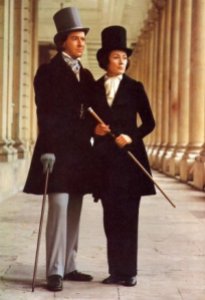
“Chopin and George Sand” in the film, “Notorious Woman.” Source: Alan Howard & the film website. http://tinyurl.com/llpxjwe
When mixed with the tobacco and the other dark elements, the result is a paradox that is very much like George Sand herself. People who haven’t read her works often know her only in the context of her turbulent affair with Chopin, or as “that cross-dressing woman who slept with the great pianist.” The truth of the matter is that her talents equaled his, and, in my opinion, she was far cleverer, far more intellectual and brilliant. She was also a trailblazing pioneer and social revolutionary in terms of her feminist impact. Yet, putting aside her intellectual and social contributions, Amantine was also a deeply sensuous woman who could also comfort Chopin like the mother that she was, or dump him to follow her desires elsewhere. (There is a lot of controversy about both their roles in their torrid, turbulent, 9-year affair, the events that ended it, and what ensued. In many ways, she broke his heart, and he never got over it.)
George, the perfume, embodies many facets of that complex woman, from her soft, feminine side to her large sensuous appetites to her dark, masculine facade. Leather and cigars, coupled with spicy, languid, indolent orange blossom neroli, and the faintest whisper of powdery, sweet heliotrope, all atop a warm, plush, deep amber base. For the longest time, George doesn’t substantially transform from that core essence. It remains largely a mix of the bitter and the sweet, the floral and the woody, the smoky and the slightly mentholated, the leathered and the ambered.
In many ways, George is an extremely linear scent, and the only changes are really ones of degree, not of kind. At the 90-minute mark, the perfume turns slightly more animalic and musky, as the slightest whiff of that horsey note I talked about appears. There is also an almost civet-like undertone to the leather, though it’s extremely subtle. about 2.5 hours in, George turns soft, silky, and a little bit abstract. It has lost all its hard edges, as the notes melt into each other to create even more of an ambered glow. Now, the perfume is primarily amber and tobacco, only lightly dusted by neroli and that tiny, small suggestion of heliotrope. It really reminds me of the story and scene with which I began this review: the cozy library parlor with sunlight streaming in, old-fashioned leather books, and the smell of cigars mixed with the flowers in the vase.
George softens further as time passes. At the start of the 5th hour, the perfume feels like labdanum amber with its warm, nutty, slightly leathered, slightly “dirty” edge. The faintest trace of some smokiness, probably from the myrrh, lingers, as does the bittersweet lushness of the florals. Whispers of minty menthol underlie the florals, along with a sweet muskiness. George’s sillage has dropped, lingering just an inch or two above the skin. By the start of the 8th hour, it is a skin scent, and by the 10.75 hour mark, it has gone. In its final moments, George is merely a nebulous blur of ambered warmth with some abstract “dark” elements and the suggestion of something floral.
I don’t think George is the easiest perfume to approach and love at first glance, but if you keep sniffing, I think you’ll see her (his?) complexity. It’s at this point that I should tell you that I own George, but I’m still a bit torn on the scent, though not always for the reasons you may imagine. Part of my problem is that I absolutely adored almost the entire Jardins d’Ecrivains line from the first sniff, but I simply couldn’t choose between them. At first, Gigi captured my attention because I’m a sucker for a big, white floral bomb. George did too, but the darkness of the opening threw me off, and Gigi was much more approachable. I went home from the lovely, adorable Marie-Antoinette boutique in Paris with different Jardins d’Ecrivains scents sprayed all over me, and some samples to try to make up my mind. I concluded that I loved Orlando. Then, I became torn between Orlando and Wilde. No, it was Gigi. No, it was Orlando and Gigi. Or was it Wilde?
I went back to Marie-Antoinette with Gigi primarily on my mind, but when I got there, I became screwed up all over again. It was becoming a nightmare to decide, and I only had that day. I sprayed George on me, and started to waffle even more. The adorable, knowledgeable owner of Marie-Antoinette helped a little by saying that there were a lot of white flower scents like Gigi, but George was the most original, different, interesting and unique. I was still dubious about it, judging by its opening blast on my skin, but he insisted that I wait 15 minutes before I smelled it again. I followed his directions — and I bought George.
It is a testament to the Jardins d’Ecrivains line that I’m still not completely sure I bought the right perfume. Orlando and Wilde remain in my head, and I have samples of both to torment me. That said, George has garnered me compliments from both women and men when I have worn it. But that opening….. it can be tough. I won’t deny it. And it most definitely won’t be for everyone. One Paris fashionista on whom I sprayed George recoiled a little, even though she followed my instructions and didn’t smell her arm until 30 minutes had passed. She’s someone who likes pure ambers or pure florals. George’s mentholated leathery darkness was too alien to her usual perfume tastes, and too masculine.
I think that is the exact reason why some reviews on Fragrantica focus on the gender classification for George, and why a few women had a hard time with the scent. The point is underscored by two very opposite impressions of George from two different women. Take, for example, this first perception of the perfume:
For the first couple minutes that this is on, it’s a warm, womanly scent with musk and hints of coffee and warm tobacco. But it quickly dries down to a bland, strange fragrance on my skin. I get the neroli and something that’s very much like a powdery spearmint. It reminds me of toothpaste and rest area bathrooms (sort of a clean-trying-to-cover-up-dirty feel). This stage lasts for about an hour on me and I really don’t like it.
Over time, I start to smell a smoky tobacco (which reminds me of someone smoking cigarettes in a bathroom) and hints of coffee again, but it’s too little too late, and is still mixed with that weird, sharp mint and soapy floor cleanser smell. It really is a dirty rest stop type of scent for me… not good.
Now, compare it to this next one:
I just have to say in rebuttal to the previous review that I, as female as they come, wore this today for the 3rd time in as many months… and now that fall is here I felt that George was adequately feminine – and certainly very, very sexy. Although the heliotrope isn’t the most obvious note, it’s at the center; I feel like George is built around it.
Recently, I’ve been wearing Archives 69 by Etat Libre which is predominantly a tobacco scent, and it’s also unisex. It warmed me up for George. Today, I wore George with pink lipstick, pink leggings and a lace top, lol! I’m a huge admirer of George Sand. Please stop whatever you’re doing right this moment and look up the movie ‘Impromptu’ from 1991, find it and watch it! This perfume *is* the scent of Amandine Aurore Lucie Dupin, who became famous for taking a man’s name, wearing trousers, and smoking cigars in public. Oh yes, this is unisex. Only it takes a special type of lover to pull it off.
That review was actually not a “rebuttal” to the first quoted comments, but to a male Fragrantica poster who essentially argued that George was not an appropriate or suitable fragrance for a traditional female. His rather sexist perceptions:
Olala Georges, GEOrges! you’re GorGEOUS!
Are you sure this is a fragrance for women too? This is really for women living alone in the middle of the forest, cutting wood, have not shaved since … what year is it anyway?, Smoking a pipe in one hand and playing arm iron of the other.
But where were they get their musk? it is either a bottle forgotten since 1902 in the basement of Guerlain or else some extract juice from Canadian lumberjack pants in beaver leather . It requires a lot to like dirty underwear.
You’ve always dreamed of spending a wild and sweating night under or on top of a bearskin picked up in a lost bar in the wild North-East? Well, you’re going to get a taste!
I love 🙂
You should see the curled lip with which I read that comment. Women can’t wear George unless they’re some dirty, uncivilized, quasi-animal-like, masculine creature living in the wild with unshaven armpits and hairy legs??! Is he serious? What century are we, and does he stick his “woman” in the kitchen with a spatula, a powdery rose perfume, and a baby under her delicate arm? I’m utterly revolted. Next, he’ll be saying that men can’t wear perfumes with roses and white flowers, even though it’s been a tradition going back over a 1000 years in the Middle East and India. What about all the European kings who wore fragrances consisting of violets and powder? Or the very female Catherine de Medici whose personal fragrance from Santa Maria Novella was the basis for what subsequently became known as men’s “cologne“? Is he going to question the masculinity of the Sultans who wore jasmine, not leather or lavender? Or are men to be applauded if they try something different, while women are to be portrayed in quasi-lesbianic stereotypes as dirty creatures who don’t shave and who live alone away from all civilizing male influence or from the desire to appeal to men? I despise gender classifications that stem from parochial, narrow-minded ignorance and bigotry. What year is this, and does he not know any history?!
My apologies for that slight detour and heated tone, as I know none of you are so ignorant, let alone Neanderthal barbarians or cavemen. You all realise that perfume is a matter of personal taste, skin chemistry, exploration, and responding to some notes more than others. But the debate between the male and female Fragrantica posters does prove that gender classification continues to play a role in perceptions of perfumery. And it’s something that irks me, even apart from the social history of perfumery. This is a current, ongoing, social perception involving gender lines that can be quite rigid, and we’re in the 21st century! I was annoyed on my visits to several Sephoras in Paris because they all created a very literal divide by placing perfumes on opposite sides, with one wall labeled as “Pour Homme,” and another labelled “Pour Femme.” I had to go back and forth from one wall to the next to try perfumes that are often wholly unisex. Who decided that the entire Serge Lutens collection belonged at the “Female” wall? Why do men feel so worried or disconcerted if they like a fragrance that they mentally classify as “female”? And why does it matter if something feels “masculine” if you like it? Isn’t that all that matters, that you like something and that it makes you feel happy?!
You’d be surprised by the questions I get from both genders worrying about whether a fragrance is too ….. something…. in one category or another. I find it so silly that society has decided to categorize lavender, to give just one example, as a more “masculine” note, while roses are ostensibly a woman’s domain. I’ll spare you the history of fragrance classification in the West, but it basically began as a 19th century marketing thing. It seems to have taken on a life of its own — to the point where a man will question a woman’s appearance, lifestyle and choices if she wears a fragrance like George. Or a woman feels she can’t wear it because it’s no longer “womanly,” to quote that one Fragrantica poster.
Putting aside this issue of gender roles, and getting back to George, I think it’s clear that Jardins d’Ecrivains succeeded admirably in its goal of creating a perfume that crosses conventional, mainstream, or typical gender lines. In that way, Anaïs Biguine created a perfume that is clearly quite polarizing but, as George’s own description bluntly states (or warns), it is a fragrance “for men and women who know who they are[.]” It is for those who are more confident in their gender identity, who don’t want to be boxed into superficial classifications of “male” scents or “female scents,” or who are open to enjoying a wider array of olfactory notes.
Does that mean that George is the easiest fragrance in the Jardins d’Ecrivains line? No, I don’t think it is. Intentionally so. However, I firmly believe that men who are comfortable enough with orange blossom can wear George, just as much as women with an appreciation for tobacco and a sometimes animalic leather. George is a fragrance that women have loved on my skin, and I believe that it is also the favorite of Jardins d’Ecrivains’ female founder. At the same time, I know quite a few men who single out George as their top pick.
Take, for example, Kevin of Now Smell This who wrote a beautiful review that talks about the real “George” as much as about the fragrance. George (the perfume) was different on his skin than on mine, and I think his experience may be instructive in showing a different side to the fragrance:
George opens with a dark, “polished” vibe; it’s heavy on delicious-smelling Peru balsam and myrrh; these notes, along with citrus, conjure a dim, shuttered study, full of books. There’s a soupçon of an acidic/sharp aroma one sometimes detects in old papers…and dried plants… […] I also detect aromas of waxed wood paneling and floors, and lit beeswax candles —- with their whiff of honey…and sweet smoke. As George develops, I smell “woody” black coffee beans, and a touch of sweet, natural-smelling tobacco (imagine a pinch of freshly cured tobacco taken from a leather pouch). Neroli and heliotrope do their work in the periphery…their scents drifting into my imagined study through open windows or Sand’s Eau de Cologne. At the end of George’s development, the rich notes turn “dusty”…providing a pungent powdery finish (the white musk in George is neither utilitarian, nor too sweet). […]
George Eau de Parfum is, appropriately, unisex [….]
[It] would have made my “Best of 2012” list if I had smelled it before that post.
As you can see, George can be different things to different people, in small part due to perceptions of gender classifications in perfumery and in notes. For this, more than for some other fragrances perhaps, it really comes down to your personal tastes and an open mind. There is no doubt that it is a very different take on white florals. In fact, I think George Sand would have thoroughly enjoyed its paradoxes, and would have tipped her top hat to Jardins d’Ecrivains.







